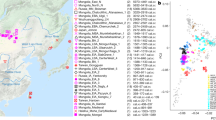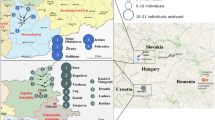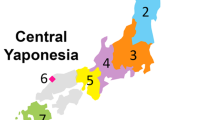Abstract
The House of Aisin Gioro, the imperial clan of Qing dynasty (1644–1911), affected the history of China and the formation of Manchu ethnicity greatly. However, owing to the lack of historical records and archeological evidences, the origin of the House of Aisin Gioro remains ambiguous. To clarify the origin of Aisin Gioro clan, we conducted whole Y-chromosome sequencing on three samples and Y-single-nucleotide polymorphism (Y-SNP) genotyping on other four samples beside those reported in previous work. We confirmed that the paternal lineage of the Aisin Gioro clan belongs to haplogroup C3b1a3a2-F8951, a brother branch of C3*-Star Cluster (currently named as C3b1a3a1-F3796, once linked to Genghis Khan), which is quite different from the predominant lineage C3c-M48 in other Tungusic-speaking populations. We also determined a series of unique Y-SNP markers for the Aisin Gioro clan. Diversity analyses of haplogroup C3b1a3a2-F8951 revealed the early migration of the ancestors of the Aisin Gioro clan from the middle reaches of Amur River to their later settlement in southeastern Manchuria. Hence, our results suggest that the Aisin Gioro clan may be descendants of ancient populations in Transbaikal region and closely related to origin of current Daur populations. Our research indicated that detailed research of stemma and deep sequencing of Y chromosomes are helpful to explore the prehistoric activities of populations lacking historical records and archeological evidences.
Similar content being viewed by others
Log in or create a free account to read this content
Gain free access to this article, as well as selected content from this journal and more on nature.com
or
References
Huang, P. New light on the origins of the Manchus. Harv. J. Asiat. Stud. 50, 239–282 (1990).
Peterson, W. J. The Cambridge History of China, The Ch'ing Dynasty to 1800, (Cambridge University Press, Cambridge, MA, USA, 2002).
Elliott, M. C. The Manchu Way: The Eight Banners and Ethnic Identity in Late Imperial China, (Stanford University Press, Redwood, CA, USA, 2001).
Yao, D & Sun, J .in Chinese Scholars in Inner Asia (eds Luo, X. & Covey, R.) (Sinor Research Institute for Inner Asia Studies, Indiana University, Bloomington, IN, USA, 2012).
Karafet, T., Xu, L., Du, R., Wang, W., Feng, S., Wells, R. S. et al. Paternal population history of East Asia: sources, patterns, and microevolutionary processes. Am. J. Hum. Genet. 69, 615–628 (2001).
Xue, Y., Zerjal, T., Bao, W., Zhu, S., Shu, Q., Xu, J. et al. Male demography in East Asia: a North–South contrast in human population expansion times. Genetics 172, 2431–2439 (2006).
Karafet, T. M., Mendez, F. L., Meilerman, M. B., Underhill, P. A., Zegura, S. L. & Hammer, M. F. New binary polymorphisms reshape and increase resolution of the human Y chromosomal haplogroup tree. Genome Res. 18, 830–838 (2008).
Zhong, H., Shi, H., Qi, X. B., Xiao, C. J., Jin, L., Ma, R. Z. et al. Global distribution of Y-chromosome haplogroup C reveals the prehistoric migration routes of African exodus and early settlement in East Asia. J. Hum. Genet. 55, 428–435 (2010).
Lell, J. T., Sukernik, R. I., Starikovskaya, Y. B., Su, B., Jin, L., Schurr, T. G. et al. The dual origin and Siberian affinities of Native American Y chromosomes. Am. J. Hum. Genet. 70, 192–206 (2002).
Duggan, A. T., Whitten, M., Wiebe, V., Crawford, M., Butthof, A., Spitsyn, V. et al. Investigating the prehistory of Tungusic peoples of Siberia and the Amur-Ussuri region with complete mtDNA genome sequences and Y-chromosomal markers. PLoS ONE 8, e83570 (2013).
Xue, Y., Zerjal, T., Bao, W., Zhu, S., Lim, S. K., Shu, Q. et al. Recent spread of a Y-chromosomal lineage in northern China and Mongolia. Am. J. Hum. Genet. 77, 1112–1116 (2005).
Yan, S., Tachibana, H., Wei, L. H., Yu, G., Wen, S. Q. & Wang, C. C. Y chromosome of Aisin Gioro, the imperial house of the Qing dynasty. J. Hum. Genet. 60, 295–298 (2015).
He, J. & Guo, F. Population genetics of 17 Y-STR loci in Chinese Manchu population from Liaoning Province, Northeast China. Forensic Sci. Int. Genet. 7, e84–e85 (2013).
Di Cristofaro, J., Pennarun, E., Mazieres, S., Myres, N. M., Lin, A. A., Temori, S. A. et al. Afghan Hindu Kush: where Eurasian sub-continent gene flows converge. PLoS ONE 8, e76748 (2013).
Lippold, S., Xu, H., Ko, A., Li, M., Renaud, G., Butthof, A. et al. Human paternal and maternal demographic histories: insights from high-resolution Y chromosome and mtDNA sequences. Invest. Genet. 5, 13 (2014).
Zheng, L. H., Sun, H. M., Wang, J. W., Li, S. L., Bai, J., Jin, Y. et al. Y Chromosomal STR polymorphism in Northern Chinese populations. Biol. Res. 42, 497–504 (2009).
Abilev, S., Malyarchuk, B., Derenko, M., Wozniak, M., Grzybowski, T. & Zakharov, I. The Y-chromosome C3* star-cluster attributed to Genghis Khan's descendants is present at high frequency in the Kerey clan from Kazakhstan. Hum. Biol. 84, 79–89 (2012).
Malyarchuk, B., Derenko, M., Denisova, G., Wozniak, M., Grzybowski, T., Dambueva, I. et al. Phylogeography of the Y-chromosome haplogroup C in northern Eurasia. Ann. Hum. Genet. 74, 539–546 (2010).
Kharkova, V. N., Khaminaa, K. V., Medvedevaa, O. F., Simonovaa, K. V., Ereminab, E. R. & Stepanova, V. A. Gene pool of Buryats: clinal variability and territorial subdivision based on data of Y-chromosome markers. Russ. J. Genet. 50, 203–213 (2014).
Yan, S., Wang, C. C., Zheng, H. X., Wang, W., Qin, Z. D., Wei, L. H. et al. Y chromosomes of 40% Chinese descend from three Neolithic super-grandfathers. PLoS ONE 9, e105691 (2014).
Y Chromosome Consortium A nomenclature system for the tree of human Y-chromosomal binary haplogroups. Genome Res. 12, 339–348 (2002).
Zhivotovsky, L. A. Estimating divergence time with the use of microsatellite genetic distances: impacts of population growth and gene flow. Mol. Biol. Evol. 18, 700–709 (2001).
Ramakrishnan, U. & Mountain, J. L. Precision and accuracy of divergence time estimates from STR and SNPSTR variation. Mol. Biol. Evol. 21, 1960–1971 (2004).
Sengupta, S., Zhivotovsky, L. A., King, R., Mehdi, S. Q., Edmonds, C. A., Chow, C. E. et al. Polarity and temporality of high-resolution y-chromosome distributions in India identify both indigenous and exogenous expansions and reveal minor genetic influence of Central Asian pastoralists. Am. J. Hum. Genet. 78, 202–221 (2006).
Wilson, I. J., Weale, M. E. & Balding, D. J. Inferences from DNA data: population histories, evolutionary processes and forensic match probabilities. J. R. Stat. Soc. Ser. A 166, 155–188 (2003).
Zhivotovsky, L. A., Underhill, P. A., Cinnioglu, C., Kayser, M., Morar, B., Kivisild, T. et al. The effective mutation rate at Y chromosome short tandem repeats, with application to human population-divergence time. Am. J. Hum. Genet. 74, 50–61 (2004).
Burgarella, C. & Navascues, M. Mutation rate estimates for 110 Y-chromosome STRs combining population and father-son pair data. Eur. J. Hum. Genet. 19, 70–75 (2011).
Twitchett, D. & Loewe, M. The Cambridge History of China, Vol. 1: The Ch'in and Han Empires 221 BC–AD 220, (Cambridge University Press, Cambridge, MA, USA, 1986).
Wei, W., Ayub, Q., Xue, Y. & Tyler-Smith, C. A comparison of Y-chromosomal lineage dating using either resequencing or Y-SNP plus Y-STR genotyping. Forensic Sci. Int. Genet. 7, 568–572 (2013).
Wang, C. C., Gilbert, M. T., Jin, L. & Li, H. Evaluating the Y chromosomal timescale in human demographic and lineage dating. Invest. Genet. 5, 12 (2014).
Zerjal, T., Xue, Y., Bertorelle, G., Wells, R. S., Bao, W., Zhu, S. et al. The genetic legacy of the Mongols. Am. J. Hum. Genet. 72, 717–721 (2003).
Lin, G. A History of Donghu [in Chinese], (Inner Mongolian People's Publishing House, Hohhot, China, 2007).
Royal-Institute The Veritable Records of the Qing, (Chinese Publishing House, Beijing, China, 2008).
Li, N. & Cribb, R. Historical Atlas of Northeast Asia, 1590–2010: Korea, Manchuria, Mongolia, Eastern Siberia, (Columbia University Press, New York, NY, USA, 2014).
Dmytryshyn, B., Crownhart-Vaughan, E. A. P. & Vaughan, T. Russia's Conquest of Siberia, 1558–1700: A Documentary Record, Vol. 1 (The Press of the Oregon Historical Society, Portland, OR, USA, 1985).
Acknowledgements
We are grateful for the trust of the sample donors. We thank the support from Sir Harumasa Tachibana during the sampling. LHW was supported by Future Scientists Project of China Scholarship Council. This work was supported by NSFC for Excellent Young Scholar (nos 31222030, 31671297, 31271338, 31401060), MOE Scientific Research Project (113022A), Ministry of Science and Technology of China (MOST) (2016YFC0900300), and Shanghai Shuguang Project (14SG05).
Author information
Authors and Affiliations
Corresponding author
Ethics declarations
Competing interests
The authors declare no conflict of interest.
Additional information
Supplementary Information accompanies the paper on Journal of Human Genetics website
Rights and permissions
About this article
Cite this article
Wei, LH., Yan, S., Yu, G. et al. Genetic trail for the early migrations of Aisin Gioro, the imperial house of the Qing dynasty. J Hum Genet 62, 407–411 (2017). https://doi.org/10.1038/jhg.2016.142
Received:
Revised:
Accepted:
Published:
Issue date:
DOI: https://doi.org/10.1038/jhg.2016.142
This article is cited by
-
Whole mitochondrial genome analysis of the Daur ethnic minority from Hulunbuir in the Inner Mongolia Autonomous Region of China
BMC Ecology and Evolution (2022)
-
Molecular genealogy of Tusi Lu’s family reveals their paternal relationship with Jochi, Genghis Khan’s eldest son
Journal of Human Genetics (2019)
-
Relating Clans Ao and Aisin Gioro from northeast China by whole Y-chromosome sequencing
Journal of Human Genetics (2019)
-
Whole-sequence analysis indicates that the Y chromosome C2*-Star Cluster traces back to ordinary Mongols, rather than Genghis Khan
European Journal of Human Genetics (2018)
-
Genetic diversity and phylogenetic characteristics of Chinese Tibetan and Yi minority ethnic groups revealed by non-CODIS STR markers
Scientific Reports (2018)



